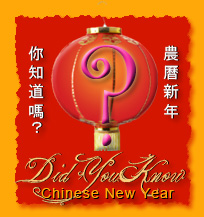Did You Know?
Facts, Figures, & Folklore
About the Chinese New Year

Did you know that the Chinese New Year lasts for 15 days?
The holiday begins on the new moon of the first lunar month of the year. It continues through the start of the full moon. The biggest celebrations during the festival are on the eve of the first day and the last full day.
Did you know that youngsters traditionally receive a gift of money from their parents or other elders on Chinese New Year?
The money, an omen of good luck for the coming year, is presented in a red envelope decorated with gold symbols of good fortune. Called Lai See, a red envelope is also traditionally given to couples on their wedding day and to children on their birthdays.
Did you know that on the fifth day of the Chinese New Year, a holiday known as Jie Cai Ceng, or the Welcoming of the Gods of Wealth, is celebrated?
Many Chinese take vacation through the fifth day of New Year festival. Merchants, on the other hand, often return to work on Jie Cai Ceng, saying special prayers for the financial success of their business in the coming year.
Did you know that preparation for the Chinese New Year begins the month before with a special day known as the Sweeping of the Grounds?
Chinese fastidiously clean their homes and business in preparation of the holiday. They also hang red scrolls on their gates to usher in good fortune.
Did you know that each of the first seven days of the Chinese New Year is associated with the birthday of a specific animal?
The first day is the birthday of the chicken, the second is the birthday of the dog; the third is pig and the fourth is the sheep. The birthday of the ox and cattle is celebrated on the fifth day, while the horse's birthday is the sixth day. The seventh day is known as the birthday of man, on which all Chinese traditionally celebrate their birthday and become a year older.
Did you know that the Chinese concept of time is cyclical rather than linear?
Each year in the Chinese calendar is ascribed to one of 12 animals signs, which repeats itself every 12 years. This cycle is known as the Sheng xiao, or the Chinese Zodiac. These animals signs are the rat, ox, tiger, rabbit, dragon, snake, horse, ram, monkey, rooster, dog and boar.
Did you know that the color, shape or even name of a food may grant it special culinary significance during the Chinese New Year?
Foods whose names are a homonym for an auspicious wish during the New Year are featured prominently. Whole fish are often eaten, for example, since the Chinese word for fish yu, which is a homonym for abundance.
Did you know that more than 1.4 billion people live in China, comprising 22% of the world's population?
Did you know that the mainland of China is more than 9.6 million square kilometers and comprises four time zones?
The country's capital, Beijing, is 16,800 square kilometers with a population of 16 million people -- more than double New York City's last census.

